Research
明確な立体構造をもったラダーポリマーの合成
Synthesis of ladder polymers with well-defined secondary structures

通常のポリマーは、モノマー単位が結合軸の周りを自由に回転できるため、多くの場合、ランダムコイル構造として存在します。しかし、DNAやタンパク質等の生体高分子が特異な立体構造を形成することで、高度な機能(認識、触媒、情報伝達、運動など)を発現していることを考えると、これは望ましい状態とはいえません。一方、ラダーポリマーは複数の結合によって主鎖の運動が制限されているため、構造の規則性が高まります。その結果、通常のポリマーに比べて、機械的強度や熱的・化学的安定性が高く、導電性や気体分離特性などの機能面でも優れた特徴を示します。さらに、規則的な立体構造を構築しやすい点も大きな強みとなります。このように、物性や機能、さらには立体構造の構築に関して非常に高い潜在力をもっています。しかし、これまで効率的な合成法が存在しなかったため、構造明確なラダーポリマーの報告例は限られ、系統的な研究がなされていませんでした。
最近、私たちは、非常に高い選択性と定量的な環化効率、そして幅広い基質適用性を兼ね備えたラダー化反応の開発に成功し、構造欠陥のないラダーポリマーを合成する方法論『無欠陥ラダー化』を確立しました。さらに、分子設計にキラリティを取り入れることで、ラダーポリマーの立体構造を自在に制御できることを見出しました。この技術を使って、らせん構造やねじれたリボン、共平面構造など、さまざまな形状の高分子を思い通りに合成できることを実証してきました。研究者の発想次第で、さらに多彩な立体構造の構築が可能になると考えられます。この合成高分子の立体構造を自在に制御する技術は、構造と物性、機能の相関を解明する上で非常に重要になります。現在、立体構造の制御技術と計算科学の融合により、ラダーポリマーの特徴を活かした高性能、高機能な高分子材料の開発を進めています。
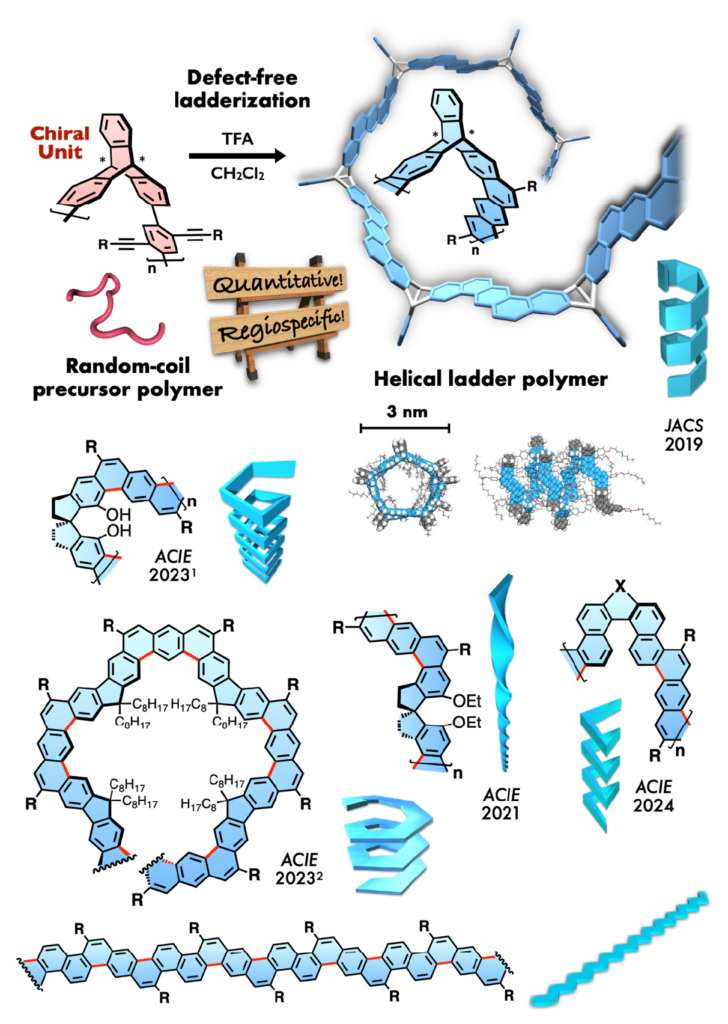
Conventional polymers often adopt a random-coil structure because their monomer units can freely rotate around the bond axis. However, when we consider how biological macromolecules like DNA and proteins form specific secondary structures to exhibit advanced functions, the random-coil structure is not ideal for functional exploration.
In contrast, the conformational freedom of ladder polymers is highly restricted due to multiple bonds, leading to the structural regularity. As a result, compared to conventional polymers, ladder polymers offer superior mechanical strength, thermal and chemical stability, and enhanced functional properties, related to charge transport and gas separation. Despite their promising potentials, the development of well-defined ladder polymers has been limited due to the lack of effective synthetic methods.
Recently, we have successfully developed a new ladderization reaction with high selectivity, quantitative cyclization efficiency, and broad substrate applicability, enabling the synthesis of a variety of defect-free ladder polymers. Furthermore, we found that incorporating chirality into the molecular design of ladder polymers allows us to precisely control their secondary structures. Using this approach, ladder polymers with different shapes—such as helical, twisted-ribbon, and coplanar structures—can be constructed. With further creative design, even more diverse three-dimensional structures would also be achieved. This technique to precisely control the secondary structure of synthetic polymers is crucial for understanding the relationship between polymer structure, properties, and function. Combined with computational science, we are now advancing the development of high-performance and highly functional materials that exploit the unique properties of ladder polymers.
関連論文
- T. Ikai, T. Yoshida, K. Shinohara, T. Taniguchi, Y. Wada, T. M. Swager, J. Am. Chem. Soc., 141, 4696-4703 (2019).
- W. Zheng, T. Ikai, E. Yashima, Angew. Chem., Int. Ed. 60, 11294-11299 (2021).
- T. Ikai, S. Miyoshi, K. Oki, R. Saha, Y. Hijikata, E. Yashima, Angew. Chem., Int. Ed. 62, e202301962 (2023).
- W. Zheng, K. Oki, R. Saha, Y. Hijikata, E. Yashima, T. Ikai, Angew. Chem., Int. Ed. 62, e202218297 (2023).
- T. Ikai, N. Mishima, T. Matsumoto, S. Miyoshi, K. Oki, E. Yashima, Angew. Chem., Int. Ed. 63, e202318712 (2024).
ラダーポリマーの機能開拓
Functional exploration in ladder polymers
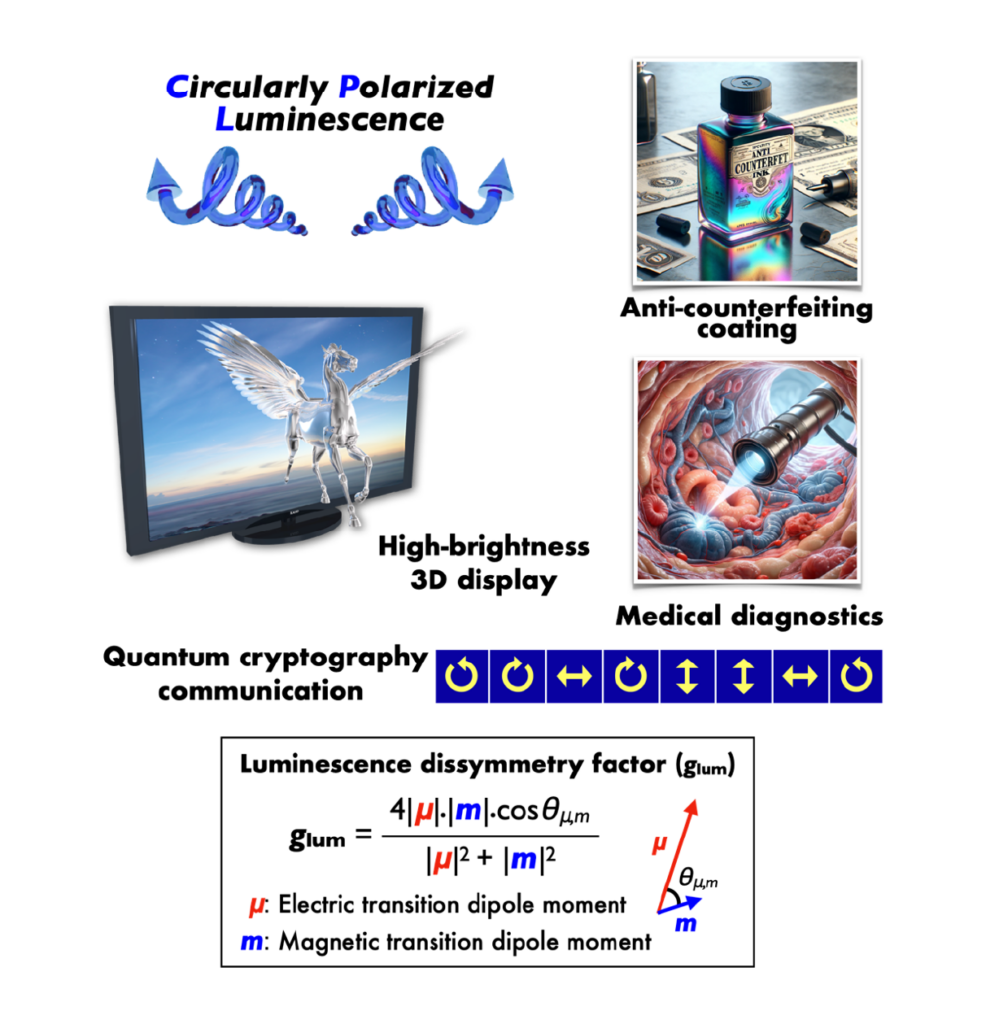
立体構造を制御することによって始めて発現するユニークな機能の開拓を行っています。
右巻きまたは左巻きのどちらか一方の光を選択的に発光できる円偏光発光 (CPL) 材料は、高輝度立体視ディスプレイや、偽造防止用塗料、医療診断、量子暗号通信等への応用が期待される次世代の光学材料として注目されています。最近、CPL材料の開発が活発化しており、円偏光発光性のキラルな高分子も多数報告されています。左右円偏光の純度を表す指標として、非対称性因子(g値)があり、これは、発光性分子の磁気および電気遷移双極子モーメントの向きと大きさによって決まります。この二つのモーメントは分子の構造に依存して変わりますが、これまで高分子の構造を制御する手段がなかったため、分子設計の指針はなく、合成、評価して、性能が良ければ幸いといった、場当たり的なアプローチに依存しているのが現状でした。
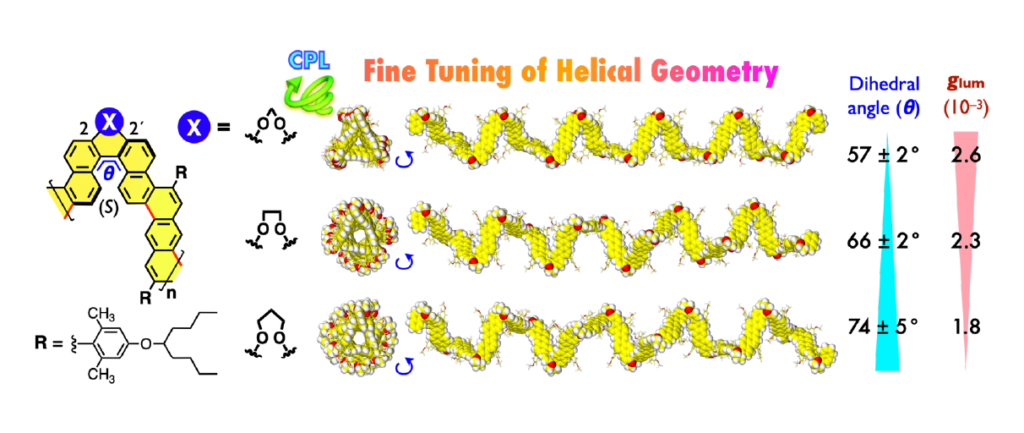
私たちは、長さの異なるアルキレンジオキシスペーサーで2,2´位を架橋したテザー型ビナフチル骨格を主鎖に導入した一連のヘリカルラダーポリマーを合成し、スペーサー長の系統的な変化に基づいた立体構造と磁気/電気遷移双極子モーメントのチューニングにより、高い蛍光量子収率とg値を併せ持った優れた円偏光発光性のポリマーが得られることを実証しました。分子レベルからボトムアップ的に円偏光発光材料を高性能化する方法論を確立できたことは、次世代の光学材料の可能性を切り拓く重要な成果になります。
We are exploring unique functions that can only be achieved by precisely controlling the secondary structure of synthetic polymers.
Circularly polarized luminescence (CPL) materials, which can selectively emit either right- or left-handed circularly polarized light, have gained attention as next-generation optical materials with potential applications in high-brightness 3D displays, anti-counterfeiting coatings, medical diagnostics, and quantum cryptography communication systems. Recently, the development of CPL materials has been intensified, and many chiral polymers showing CPL have been reported. A key indicator of the CPL materials is the luminescence dissymmetry factor (g-value), which is determined by the orientation and magnitude of the magnetic and electric transition dipole moments of the fluorophores. These two moments vary with the molecular structure. Until now, however, there has been no reliable way to control polymer geometries, so the molecular design of CPL materials has largely relied on a trial-and-error approach-synthesizing, testing, and hoping for good performance without a clear guide.
In this context, we have synthesized a series of defect-free 2,2′-tethered binaphthyl-embedded one-handed helical ladder polymers with different alkylenedioxy tether lengths. The helical structures and magnetic/electric transition dipole moments could be finely modulated by controlling the binaphthyl dihedral angle with variations in the alkylenedioxy tether groups, leading to a strong CPL with a high fluorescence quantum yield. The establishment of this bottom-up approach to improve the CPL performance represents a significant breakthrough, opening up new possibilities for next-generation chiroptical materials.
関連論文
- T. Ikai, N. Mishima, T. Matsumoto, S. Miyoshi, K. Oki, E. Yashima, Angew. Chem., Int. Ed. 63, e202318712 (2024).
また、立体制御技術を分離・分子認識材料の開発に応用することもできます。例えば、6,6´位連結型1,1´-スピロビインダン骨格をキラルユニットに用いて無欠陥ラダー化を行うと、分子認識に適した1 nm程度の不斉ナノ空孔を構築することができます。さらにこの場合、空孔内壁がπ電子で覆われることになるため、空孔内部でπ電子を介した相互作用が可能となり、有望なホスト材料になると期待できます。実際に、HPLC用キラル分離剤としての応用したところ、点、軸、面不斉化合物に対して優れた光学分割能を発現することを明らかにしました。現在、立体構造制御に基づいて、生体系に匹敵、さらには生体系を超える高度な機能の創出を目指して研究を進めています。
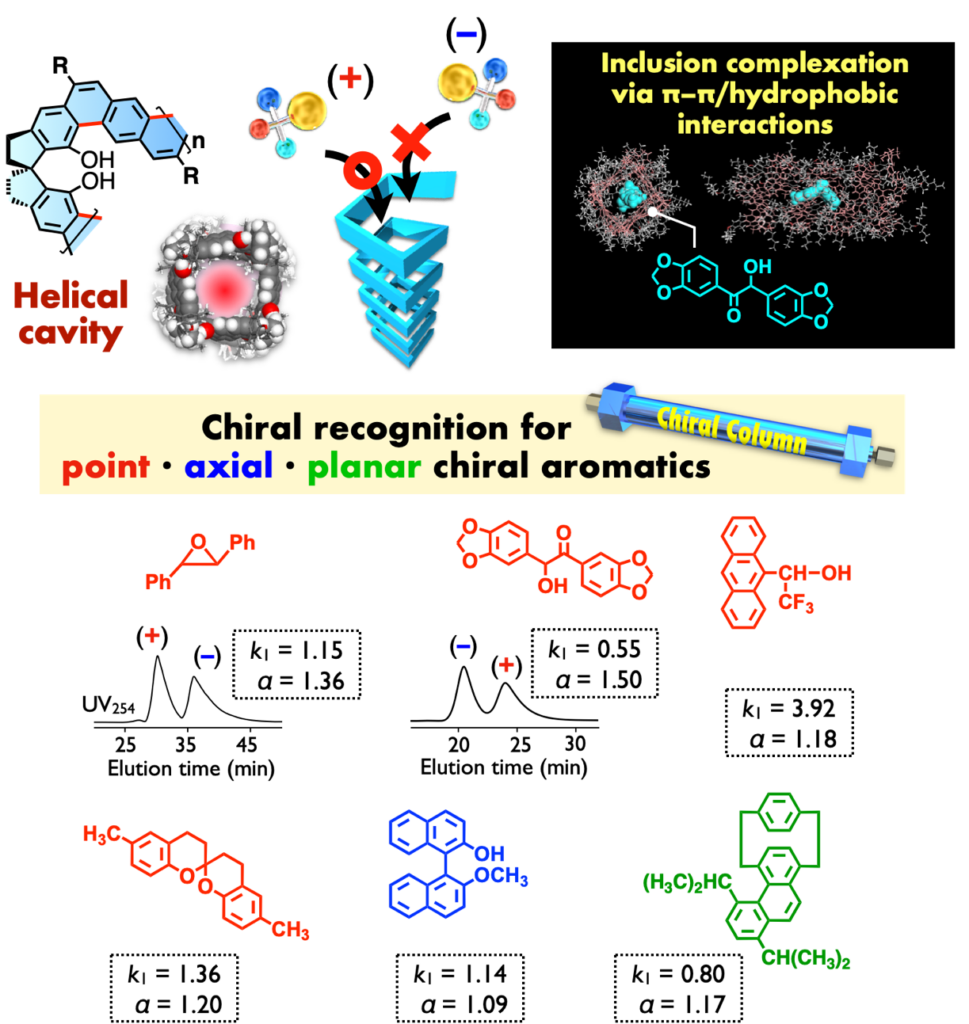
In addition, our structural control technique can be applied to the development of molecular recognition materials. For example, by using an optically-active 6,6′-linked-1,1′-spirobiindane unit, we can construct a chiral cavity of ca. 1 nm suitable for molecular recognition. In this case, the inner wall of the cavity is covered with π-electrons, allowing effective interactions with guest molecules, making it a promising host material. In fact, when used as a chiral stationary phase for HPLC, it has shown excellent resolution capabilities for a variety of compounds with point, axial and planar chirality. Our ongoing research aims to exploit secondary structure control to create advanced functionalities that rival or even surpass those found in biological systems.
ヘリセン化合物の合成
Helicene synthesis
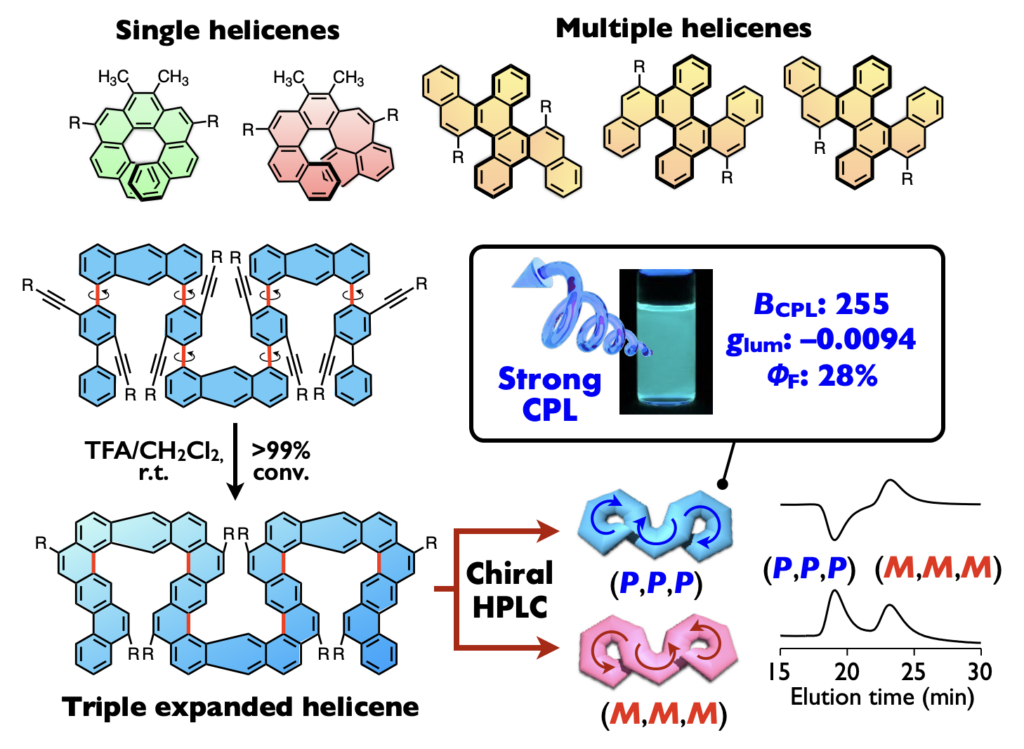
ヘリセンは、複数の芳香環が縮環した多環芳香族化合物の一種で、芳香環同士の立体障害によって分子全体がねじれ、らせん構造をとることで知られています。ヘリセン類は、その非平面π共役骨格に由来して、特徴的な光学的・電気的・磁気的性質を示すため、光学材料や触媒、センサー、分子スイッチなど、さまざまな分野での応用が期待されています。無欠陥ラダー化は、π共役骨格を拡張させる反応なので、前駆体の分子設計次第ではヘリセン類の合成に応用することができます。実際に、単純な構造のヘリセンから、七員環骨格を含むもの、分子内に複数のヘリセン骨格を含む多重ヘリセン、さらには螺旋径の大きな拡張ヘリセン(expanded helicene)などを合成することができ、それらの機能開拓を行なってきました。たとえば、アントラセン誘導体の無欠陥ラダー化により、M字型構造をもつトリプル型拡張ヘリセンを化学選択的かつ定量的に合成することに成功しています。また、この化合物が、高度にねじれたπ共役骨格に由来して優れた円偏光発光(CPL)特性を示し、ヘリセン系化合物の中でも最高レベルのCPL性能(CPL brightness (BCPL) = 255 M−1·cm−1)を示すことを見出しました。最近では、ヘリセン骨格からなる新しいタイプのポリマーの合成も行なっており、その秘められた物性や機能の解明を進めています。
Helicenes are a class of polycyclic aromatic compounds composed of fused aromatic rings and are known to adopt a helical structure due to the intramolecular steric effect. Helicenes exhibit unique optical, electrical, and magnetic properties derived from their non-planar π-conjugated framework, making them promising candidates for various applications, such as optical materials, catalysts, sensors, and molecular switches.
The defect-free ladderization is a reaction that can extend the π-conjugated framework, and thus it can be applied to the helicene synthesis. Indeed, we have synthesized a wide variety of helicenes, ranging from simple structures to those containing seven-membered ring systems, multiple helicenes composed of several helicene substructures in a single molecule, and even expanded helicenes with larger helical diameters. We have also explored the functions of these compounds. For example, we can synthesize a triple expanded helicene with an M-shaped structure in a highly chemoselective and quantitative manner by defect-free ladderization of an anthracene derivative. This compound exhibited excellent CPL properties due to its highly twisted π-conjugated framework, and provided one of the highest CPL performances among helicene-based compounds, with a CPL brightness (BCPL) of 255 M−1·cm−1. More recently, we have also synthesized novel helicene-based polymers and are currently investigating their unique properties and potential functions.
関連論文
- T. Ikai, S. Yamakawa, N. Suzuki, E. Yashima, Chem. Asian J., 16, 769–774 (2021).
- W. Zheng, T. Ikai, K. Oki, E. Yashima, Nat. Sci. 2, e20210047 (2022).
- T. Ikai, K. Oki, S. Yamakawa, E. Yashima, Angew. Chem., Int. Ed., 62, e202217020 (2023).
高分子を構成成分とする超分子ポリマーの合成と不斉増幅
Synthesis of supramolecular polymers composed of macromolecules and amplification of asymmetry

連鎖重合と超分子重合が交互かつ連続的に進行する乗り継ぎ型メリーゴーランド(T-MGR)重合を開発し、明確な二次構造を有する高分子が末端間で非共有結合的に連結した生体類似の一次元超分子集合体の合成に成功しました。超分子鎖が一次元方向に伸長する過程で非常に強い不斉増幅が起こるだけでなく、得られた超分子鎖が不斉に捻れた三次元構造体へと自発的かつ階層的に集積化することを明らかにしました。さらに、超分子集合体のキラリティの情報を他の化合物に不斉伝搬させることにも成功し、汎用的なアキラルな色素分子に高度な円偏光発光機能を付与できることを実証しました。本研究の機能性分子への不斉伝搬技術は、安価な原料から高付加価値材料の創製を可能にするため、最近特に関心がもたれています。
We have developed a transit-type merry-go-round (T-MGR) polymerization, where chain polymerization and supramolecular polymerization proceed alternately and continuously. This technique allowed the synthesis of biomimetic one-dimensional supramolecular assemblies, in which polymers with well-defined secondary structures are non-covalently linked at their ends. During the T-MGR polymerization, we observed not only a significant amplification of chirality but also a spontaneous and hierarchical self-assembly of the resulting supramolecular chains into twisted three-dimensional structures. In addition, the chiral information of the supramolecular assembly can be transferred to other compounds, imparting advanced CPL properties to achiral dye molecules. This chirality transfer to functional molecules has recently attracted attention as a promising approach to produce high value-added materials from inexpensive raw materials.
関連論文
- Y. Wada, K. Shinohara, H. Asakawa, S. Matsui, T. Taima, T. Ikai, J. Am. Chem. Soc., 141, 13995-14002 (2019).
- T. Ikai, M. Okubo, Y. Wada, J. Am. Chem. Soc., 142, 3254-3261 (2020).
